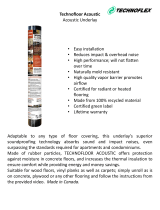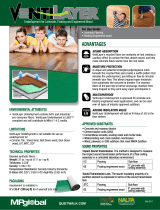
c. High areas, such as peaked joints in the subfloor or
other ridges in the wood subfloor must be sanded
or planed and low areas repaired or filled with a
Portland cement and latex based leveling com-
pound or covered with a rigid underlayment. When
using a leveling compound, be sure to follow the
manufacturer’s recommendations, and allow the
compound to dry completely before starting to
install the Pergo Flooring. See Subfloor Requirements/
General, section 7, paragraph a.
d. Pergo Moisturbloc
TM
and Pergo SoftSeal
TM
or a polyeth-
ylene film must not be used on the top of a wooden
floor or wood subfloor. These products are only used
on concrete subfloors.
e. When the subfloor is wooden, Pergo laminate flooring
can be installed over parquet, planks or other wood
flooring or wood based flooring installed on the
wood subfloor.
f. If you have questions or doubts about how to
proceed in your situation, call us at 1-800-33-PERGO
(1-800-337-3746).
IMPORTANT NOTE: Du
ring a dry season, you may find that
you get an acceptable moisture reading even if other
job site conditions are n o t acceptable. Before installing
Pergo floors, you must be sure that your job site condi-
tions as well as your moisture readings are acceptable.
g. Should excessive moisture be present or if the job site
conditions are not correct consult a waterproofing or
flooring contractor for further moisture testing or
abatement before installing a Pergo floor.
9. C O N C R E TE A N D TE R R A ZZO S UB FLO O R
R E Q UIR E M E N TS — When installing Pergo flooring, the
maximum acceptable moisture reading for concrete
subfloors is 4.5% or a moisture vapor emission rate of
5lbs/1000sq. ft./24 hrs.
a. Concrete and terrazzo release moisture long after
it is poured and can transfer dampness from wet soil
and the air, i.e., elevated concrete floors in apartment
and office buildings. New concrete must cure for
60 days before any flooring is installed.
b. Check the floor for flatness. If the concrete or terrazzo
subfloor has excessive voids or variations, a leveling
compound can be used to bring it up to specifications.
(See Subfloor Requirements/General.) Low areas
greater than
3
⁄16" in a 10' radius should be filled in using
a Portland cement and latex-based floor leveler.
Follow the manufacturer’s directions for mixing the
filler, and be sure to allow it to dry completely. High
spots or ridges above
3
⁄16" within a 10' radius must
be ground down.
c. When inst
alling Pergo flooring over a concrete or
terrazzo subfloor you must use a 6-mil. (.15mm) non-
recycled (100% virgin) resin polyethylene film such as
Pergo Moisturbloc
TM
or Pergo SoftSeal
TM
combination
foam/film to form a vapor barrier. When the Pergo
Product has an attached underlayment foam, use
only a vapor barrier with this product when installing
over a concrete subfloor. The edges of the vapor
barrier must overlap by at least 8 inches (200mm) or
when using an equivalent, non-recycled, polyethylene
film, follow the manufacturer’s direction for installation.
Vapor barrier underlayments are required over all
subfloors containing concrete, even if the concrete is
covered by vinyl, linoleum VCT (resilient tile), terrazzo
or ceramic tile.
d. Evaluation of moisture conditions for concrete or terrazzo
subfloors. (Also see Job Site Evaluation–exterior and
interior moisture conditions–section 6.) If there is
excessive moisture in the concr
ete or the job site
conditions are not correct then Pergo flooring cannot
be installed.
e. When a resilient tile is installed over concrete subfloors
and there is visible salt deposits at any of the joints
of the tile there is reason to believe that excessive
moisture is present.
f. A precise moisture reading can be obtained using
the Calcium Chloride Test. Three tests must be used
for the first 1000 sq. ft. and one additional test for
each 1000 sq. ft. or fraction thereof (ASTM 1869-03).
The results of the tests must not exceed 5lbs/1000
sq.ft/24 hrs (not to exceed five pounds of water
vapor being emitted from 1000 square feet of
flooring over a period of 24 hours).
g. Moisture meters, correctly calibrated, and used
can also provide moisture readings. See the meter
manufacturer’s instructions for use and interpretation
of the meter readings.
h. Do not install Pergo flooring in a room with a floor drain.
i. Do not install Pergo flooring over a floor with a sump
pum
p. Pergo flooring must not be installed over any
floor that has a sump pump, i.e. should there be a
floor at a below grade or an on-grade level concrete
slab in the home and a sump pump is located in that
below-grade level flooring or in the on-grade level
slab, then Pergo flooring cannot be installed anywhere
on that floor.
IMPORTANT NOTE: During a dry season, you may find that
you get an acceptable moisture reading even if other
job site conditions are not acceptable. Before installing
Pe
rgo floors, you must be sure that your job site conditions
as well as your moisture readings are acceptable.
j. Should excessive moisture be present or the job site
conditions are not correct, consult a waterproofing
or flooring contractor for further moisture testing or
abatement before installing a Pergo floor.
10 . O TH E R S UB FLO O R R E Q UIR E M E N TS
a. Vinyl sheet goods, linoleum and resilient (VCT) tiles:
Old vinyl and linoleum tiles or sheet goods normally
do not need to be remov
ed. Some older vinyl sheet
goods and tile contain asbestos. Should you choose
to remove these older floor coverings, consult a floor
covering retailer or the manufacturer of the vinyl floor
covering regarding the contents. Should it contain
asbestos special precautions for your safety must
be taken.
b. When Pergo flooring is installed over vinyl, linoleum
sheet goods, over resilient tiles or ceramic tiles and
the subfloor is concrete, a vapor barrier is always
required.













